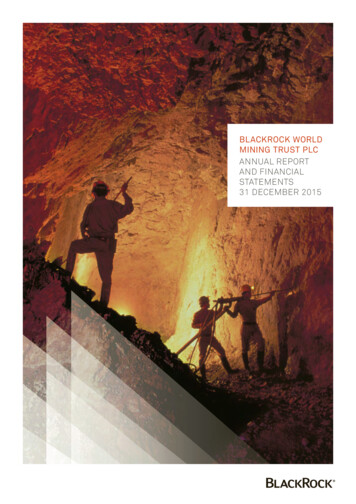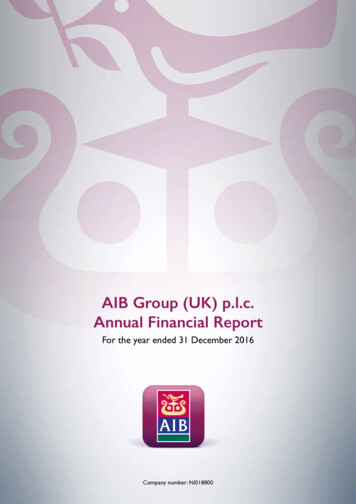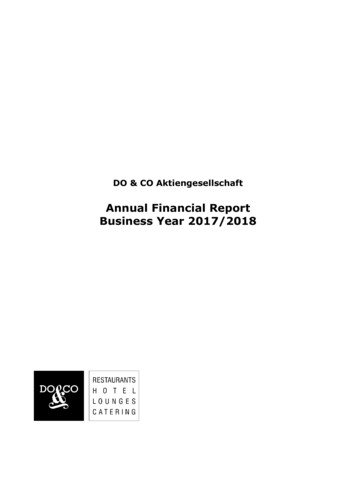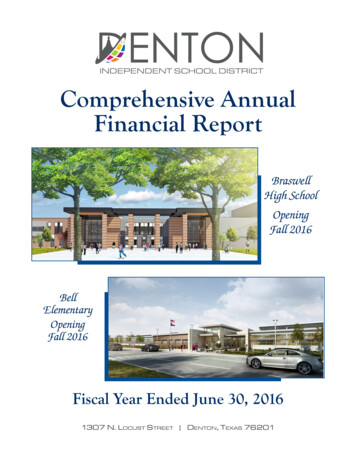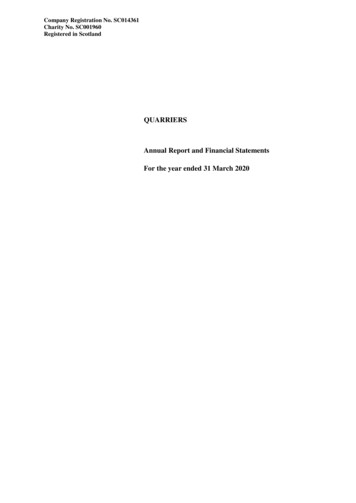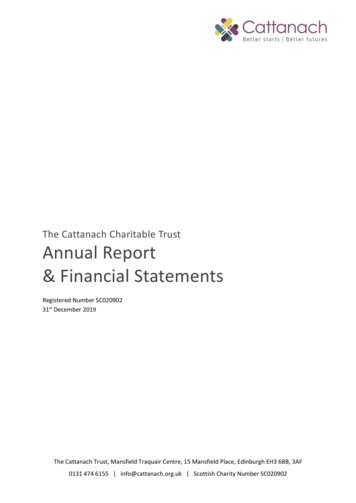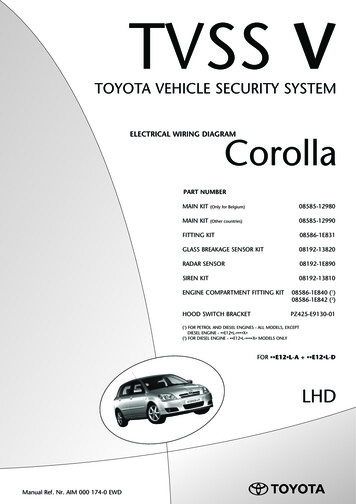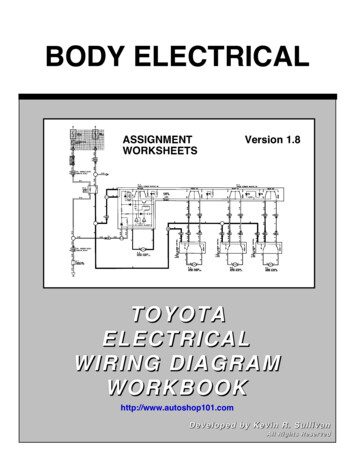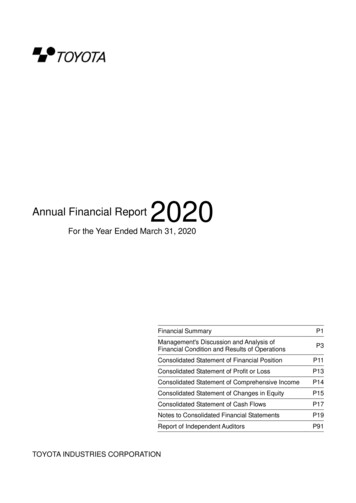
Transcription
Annual Financial Report2020For the Year Ended March 31, 2020Financial SummaryP1Management's Discussion and Analysis ofFinancial Condition and Results of OperationsP3Consolidated Statement of Financial PositionP11Consolidated Statement of Profit or LossP13Consolidated Statement of Comprehensive IncomeP14Consolidated Statement of Changes in EquityP15Consolidated Statement of Cash FlowsP17Notes to Consolidated Financial StatementsP19Report of Independent AuditorsP91TOYOTA INDUSTRIES CORPORATION
Financial SummaryToyota Industries Corporation and its consolidated subsidiaries IFRS 003,9732,214,9462,171,355Operating profit (Millions of yen)137,026127,345147,445134,684128,233Profit (Millions of yen)199,956137,565173,816159,778150,187Profit: attributable to owners of the parent(Millions of ve income (Millions of yen)(253,021)202,743361,599(16,789)10,474Share of equity attributable to ownersof the parent (Millions of otal assets (Millions of ,678.807,215.378,223.827,986.597,854.87Earnings per share-basic (Yen)618.34420.78541.67491.97469.85Earnings per share-diluted 788]Net sales (Millions of yen)Equity per share: attributable to ownersof the parent (Yen)Ratio of equity attributable to ownersof the parent to total assets (%)Return on equity attributable to ownersof the parent (%)Price-to-earnings ratio (Times)Net cash provided by operating activities(Millions of yen)Net cash used in investing activities(Millions of yen)Net cash provided by financing activities(Millions of yen)Cash and cash equivalents at end of period(Millions of yen)Number of employees[Average number of part-time employees,not included in number of employees above](Notes) 1. Toyota Industries Corporation and its subsidiaries have adopted International Financial ReportingStandards ("IFRS") for the consolidated financial statements of the annual report from the fiscal year endedMarch 31, 2017. The date of transition to IFRS is April 1, 2015.(Notes) 2. Net sales do not include consumption taxes.(Notes) 3. Amounts for diluted earnings per share are not presented for FY2017, FY2018, FY2019 and FY2020because there are no shares with a potentially dilutive effect.(Notes) 4. Number of employees is the number of workers (excluding people dispatched from the Group to outside theGroup, but including people dispatched from outside the Group to the Group).―1―
Japanese GAAP FY2016Net sales (Millions of yen)FY20172,243,2202,250,466Ordinary profit (Millions of yen)185,398177,121Profit: attributable to owners of the parent(Millions of yen)183,036125,534Comprehensive income (Millions of yen)(277,053)198,548Total equity (Millions of yen)2,113,9482,256,271Total assets (Millions of yen)4,199,1964,428,6446,481.976,995.47Earnings per share-basic (Yen)582.58402.00Earnings per share-diluted (Yen)582.57―48.5049.04Return on equity (%)8.335.97Price-to-earnings ratio ]Equity per share (Yen)Equity-to-total assets ratio (%)Net cash provided by operating activities(Millions of yen)Net cash used in investing activities(Millions of yen)Net cash provided by (used in) by financingactivities (Millions of yen)Cash and cash equivalents at end of period(Millions of yen)Number of employees[Average number of part-time employees,not included in number of employees above](Notes) 1. Amounts for FY2017 are unaudited financial information pursuant to the first paragraph of Article 193-2 ofthe Financial Instruments and Exchange Act.(Notes) 2. Net sales do not include consumption taxes.(Notes) 3. Certain FY2016 amounts have been reclassified to conform to the changes in presentation in FY2017.(Notes) 4. Amounts for diluted earnings per share are not presented for FY2017 because there are no shares with apotentially dilutive effect.(Notes) 5. Number of employees is the number of workers (excluding people dispatched from the Group to outside theGroup, but including people dispatched from outside the Group to the Group).―2―
Management's Discussion and Analysis of Financial Condition and Results of OperationsThe following Management's Discussion and Analysis of Financial Condition and Results of Operations is based oninformation known to management as of June 2020.This section contains projections and forward-looking statements that involve risks, uncertainties and assumptions. Youshould be aware that certain risks and uncertainties could cause the actual results of Toyota Industries Corporation and itsconsolidated subsidiaries to differ materially from any projections or forward-looking statements. These risks anduncertainties include, but are not limited to, those listed under "Risk Information" and elsewhere in this annual report.The fiscal year ended March 31, 2020 is referred to as FY2020 and other fiscal years are referred to in a correspondingmanner. All references to the "Company" herein are to Toyota Industries Corporation on a stand-alone basis andreferences to "Toyota Industries" herein are to the Company and its 256 consolidated subsidiaries.1. Result of Operations(1) Operating PerformanceIn FY2020 (ended March 31, 2020), the global economy was solid overall despite such uncertainties as thedeceleration of the Chinese economy arising from U.S.-China trade frictions and geopolitical risks. However, during thefew months leading to the fiscal year-end the global economy went on a dramatic downward spiral due to the spread ofCOVID-19. Meanwhile, the Japanese economy deteriorated during the second half of FY2020. In addition to the factorsmentioned above, the primary reasons for the deterioration included a decrease in anemic consumer spending thataccompanied the consumption tax hike and natural disaster. In this operating environment, Toyota Industries undertookefforts to ensure customer trust through a priority to quality as well as to respond flexibly to market trends.Total consolidated net sales amounted to 2,171.3 billion yen, a decrease of 43.6 billion yen, or 2%, from the previousfiscal year.(2) Operating Performance Highlights by Business SegmentOperating results by business segment are as follows.Net sales for each segment do not include inter-segment transactions.(Automobile)The automobile market remained roughly on par with the previous fiscal year in Japan despite contraction in otherareas. Amid such operating conditions, net sales of the Automobile Segment totaled 613.8 billion yen, an increase of3.1 billion yen, or 1%. Operating profit amounted to 17.2 billion yen, an increase of 10.4 billion yen, or 153%, from theprevious fiscal year.Within this segment, net sales of the Vehicle Business amounted to 89.9 billion yen, an increase of 7.5 billion yen, or9%, due mainly to increases in sales of the new RAV4 whose production started in November 2018.Net sales of the Engine Business totaled 122.4 billion yen, an increase of 14.0 billion yen, or 13%, resulting mainlyfrom increases in sales of new A25A and M20A gasoline engines.Net sales of the Car Air-Conditioning Compressor Business totaled 328.1 billion yen, a decrease of 18.1 billion yen, or5%. Sales in Japan increased while those in North America and Europe decreased.Net sales of Electronics Parts, Foundry and Others Business totaled 73.2 billion yen, on par with the previous fiscalyear. This was because decreases in sales of foundry products were offset by increases in sales of electronics parts.―3―
(Materials Handling Equipment)The materials handling equipment market remained roughly on par with the previous fiscal year in North America, whileit shrank in Europe. Amid this operating climate, net sales of the Materials Handling Equipment Segment totaled1,436.3 billion yen, a decrease of 30.3 billion yen, or 2%. This was due primarily to decreases in sales of mainstay lifttrucks and the impact of exchange rate fluctuations. Operating profit amounted to 102.2 billion yen, a decrease of 12.4billion yen, or 11%, from the previous fiscal year.(Textile Machinery)The textile machinery market was stagnant in Asia, including China, Toyota Industries' primary market. Net sales of theTextile Machinery Segment totaled 61.7 billion yen, a decrease of 14.6 billion yen, or 19%, due mainly to decreases insales of weaving machinery and yarn quality measurement instruments.Operating profit amounted to 2.9 billion yen, a decrease of 4.4 billion yen, or 60%, from the previous fiscal year.(3) Operating profitOperating profit for FY2020 was 128.2 billion yen, a decrease of 6.4 billion yen, or 5%, from the previous fiscal year.This was due mainly to the impact of COVID-19, Typhoon No. 19 (Hagibis) and exchange rate fluctuations, partiallyoffset by sales efforts and increases in promoting cost reduction efforts throughout the Toyota Industries Group.(4) Profit before income taxesProfit before income taxes amounted to 196.2 billion yen, a decrease of 6.0 billion yen, or 3%, from the previous fiscalyear. This was due mainly to a decrease in operating profit of 6.4 billion yen, or 5%, from the previous fiscal year to128.2 billion yen.(5) Profit attributable to owners of the parentProfit attributable to owners of the parent totaled 145.8 billion yen, a decrease of 6.9 billion yen, or 4%, from theprevious fiscal year.Earnings per share-basic was 469.85 yen compared with 491.97 yen in the previous fiscal year.2. Consolidated Financial ConditionTotal assets amounted to 5,279.6 billion yen, an increase of 18.5 billion yen from the end of the previous fiscal year. Thiswas because a decrease in fair value of investment securities was offset mainly by an increase in cash and cashequivalents, and property, plant and equipment. Liabilities amounted to 2,759.1 billion yen, an increase of 59.9 billion yenfrom the end of the previous fiscal year, due mainly to an increase in corporate bonds and loans. Equity amounted to2,520.5 billion yen, a decrease of 41.4 billion yen from the end of the previous fiscal year.3. Liquidity and Capital Resources(1) Capital needs and returning profits to shareholdersToyota Industries' primary capital needs are twofold, specifically, long-term capital needs for research and development,capital investment, M&A and others as well as working capital needs for purchasing raw materials and parts formanufacturing the Group's products and for manufacturing costs and selling, general and administrative expenses.In addition to prioritizing fund allocation in research and development and capital investment, it is Toyota Industries'policy to invest funds in M&A and others when deemed necessary for business expansion and sustainable growth.As for returning profits to shareholders, it is determined to pay dividends at the consolidated dividend payout ratio ofaround 30%. In regard to dividend policy, refer to "7. Dividend Policy".―4―
(2) Financial policyToyota Industries' financial policy is to ensure sufficient financing for its business activities and to maintain sufficientliquidity and strong consolidated financial position. Toyota Industries continues to maintain its solid financial condition.Through the use of such current assets as cash and cash equivalents and short-term investments, as well as cashflows from operating activities, issuance of corporate bonds and loans from financial institutions, Toyota Industriesbelieves that it will be able to provide sufficient funds for the working capital necessary to expand existing businessesand develop new projects.Toyota Industries receives credit ratings from S&P Global Ratings Japan Inc., Moody's Japan K.K. and Rating &Investment Information, Inc. and strives to maintain and improve its ratings to procure funds at favorable terms.Regarding fund management, the Company undertakes integrated fund management of its subsidiaries in Japan, whileToyota Industries North America, Inc. (TINA) and Toyota Industries Finance International AB (TIFI) centrally managethe funds of subsidiaries in North America and Europe, respectively. Through close cooperation among the Company,TINA and TIFI, we strive to improve efficiency of funds operations.4. Cash FlowsNet cash provided by operating activities was 313.1 billion yen in FY2020, due mainly to posting profit before income taxesof 196.2 billion yen. Net cash provided by operating activities increased by 42.8 billion yen compared to net cash providedby operating activities of 270.3 billion yen in the previous fiscal year.Net cash used in investing activities was 182.5 billion yen in FY2020, attributable primarily to payments for bank depositsof 547.6 billion yen and payments for purchases of property, plant and equipment of 216.0 billion yen, which offsetproceeds from withdrawals of bank deposits of 594.7 billion yen. Net cash used in investing activities decreased by 212.5billion yen compared to net cash used in investing activities of 395.0 billion yen in the previous fiscal year.Net cash used in financing activities was 7.0 billion yen in FY2020 compared with a net cash provided of 40.4 billion yen inthe previous fiscal year, due mainly to repayments of long-term loans payable of 122.9 billion yen and repayments ofcorporate bonds of 93.8 billion yen, which together offset proceeds from long-term loans payable of 183.1 billion yen.After adding translation adjustments and cash and cash equivalents at beginning of period, cash and cash equivalents asof March 31, 2020 stood at 358.1 billion yen, an increase of 119.0 billion yen, or 50%, from the end of the previous fiscalyear.5. Investment in Property, Plant and EquipmentDuring FY2020, Toyota Industries made a total investment of 255,015 million yen in property, plant and equipment(including materials handling equipment for operating lease) in order to launch new products, streamline and upgradeproduction equipment.In regard to investment in property, plant and equipment by the reporting segments, investment in property, plant andequipment in Automobile, Materials Handling Equipment, Textile Machinery and Others were 69,239 million yen, 180,398million yen, 1,409 million yen and 3,968 million yen, respectively.―5―
6. Strategies and OutlookOutlook for Results for FY2021With regard to the future economic outlook, uncertainties abound including U.S.-China trade frictions, geopolitical risks andconcerns over the prolonged spread of COVID-19. As such, the environment surrounding Toyota Industries' majorbusinesses, namely Automobiles and Materials Handling Equipment, preclude optimism.Amid this challenging environment, Toyota Industries will continue to undertake concerted efforts to strengthen itsmanagement platform and raise corporate value.To quickly respond to dramatic changes in the business environment, we will strengthen risk management and carry outthorough cost improvement activities to transform ourselves into a more muscular and resilient management platform. Inaddition, we will strive to improve productivity in the back-office operations through work style reforms and reduce fixedcosts.Moreover, we will raise the competitiveness of our businesses and aim for further growth by promoting innovativetechnology and product development while also proactively embracing digital technologies and open innovation. Tosupport such business development, we will continue our efforts to create an organization and workplace environment thatenables diverse human resources to fully demonstrate their abilities and develop personnel who learn and think on theirown and quickly take the initiative.In other areas, Toyota Industries will create a workplace environment that places top priority on safety; ensurethoroughgoing compliance, including adherence to laws and regulations; and proactively participate in social contributionactivities. By carrying out these initiatives, we aim to broadly meet the trust of society and grow harmoniously with society.With regard to protection of the global environment, we will undertake Group-wide initiatives toward the realization of "azero CO2 emission society in 2050".Through these initiatives, we aim for sustainable growth of each business and strive to support industries and socialfoundations around the world and contribute to making the earth a better place to live, enriched lifestyles and acomfortable society as described in Toyota Industries' Vision 2030.7. Dividend PolicyToyota Industries intends to meet the expectations of shareholders for continuous dividends while giving full considerationto business performance, funding requirements, the dividend payout ratio and other factors.Toyota Industries' Board of Directors meeting, held on April 30, 2020, approved a year-end cash dividend of 80.0 yen pershare. Including the interim cash dividend of 80.0 yen per share, cash dividends for the year totaled 160.0 yen per share.Toyota Industries will use retained earnings to improve the competitiveness of its products, augment production capacity inJapan and outside Japan, as well as to expand into new fields of business and strengthen its corporate constitution insecuring future profits for its shareholders.The Company's Articles of Incorporation stipulate that it may pay interim cash dividends as prescribed in Article 454-5 ofthe Companies Act and it is the Company's basic policy to pay dividends from retained earnings twice a year (interim andyear-end).The Company's Articles of Incorporation also stipulate that what is prescribed in Article 459-1 of the Companies Act can beadded to the Articles of Incorporation.―6―
8. Risk InformationThe following represent risks that could have a material impact on Toyota Industries' financial condition, business resultsand share prices. Toyota Industries judged the following as future risks as of March 31, 2020.(1) Principal CustomersToyota Industries' automobile and engine products are sold primarily to Toyota Motor Corporation ("TMC"). In FY2020,net sales to TMC accounted for 11.2% of consolidated net sales. Therefore, TMC's vehicle sales could have an impacton Toyota Industries' business results. As of March 31, 2020, TMC holds 24.7% of the Company's voting rights.(2) Product Development CapabilitiesBased on the concept of "developing appealing new products", Toyota Industries proactively develops new products byutilizing its leading-edge technologies, as it strives to anticipate increasingly sophisticated and diversifying needs of themarket and ensure the satisfaction of its customers.R&D activities are focused mainly on developing and upgrading products in current business fields and peripheralsectors. Toyota Industries expects that revenues derived from these fields will continue to account for a significantportion of total revenues and anticipates that future growth will be contingent on the development and sales of newproducts in these fields. Toyota Industries believes that it can continue to develop appealing new products. However,Toyota Industries may not be able to forecast market needs and develop and introduce appealing new products in atimely manner. This could result in lower future growth and have an adverse impact on Toyota Industries' financialcondition and business results.Such a situation could result from risks that include that there is no assurance that Toyota Industries will be able toallocate sufficient future funds necessary for the development of appealing new products; no assurance that productsales will be successful, as forecasts of products supported by the market may not always be accurate; and noassurance that newly develo
― 1 ― Financial Summary Toyota Industries Corporation and its consolidated subsidiaries IFRS FY2016 FY2017 FY2018 FY2019 FY2020 Net sales (Millions

